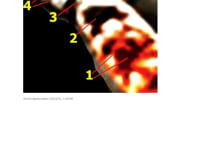Multiple Sclerosis (MS) is recognized as one of the most challenging and debilitating diseases affecting children and is the most common neurological disorder seen in young adults. Although the mechanisms by which MS progressively results in neurodegenerative changes are evident these are not well understood. The latest medical break-throughs in understanding, treatment, and knowledge leading to a cure give suggestive evidence that neurodegeneration occurs early in the course of MS. Further, that a unique cell ('soldier cell') is involved and is thought to be responsible for prolonged periods of debilitation, sustained degenerative neurological disorders and accumulation of disability.
A new diagnostic tool, called, 'ORIE', the acronym representing 'Optical Remote Image Enhancement ' has been developed by the Respondent(s). The ORIE technology is non-invasive in nature, is painless and exploits radio-imaging technologies, e.g., CAT-scan, PET-scan, and advances instant imaging protocols to the 'next-generation' of investigative and analytical capability. The ORIE system identifies structures, elements and compounds contained in the subject of study. In study #1) ORIE shows that there exists a heretofore unidentified carbon based protein precursor cell. This cell, called a 'soldier cell' first consumes all of the oxygen in the dendrite and myelin sheath. We term is event, 'The Genesis Effect'. Once the oxygen is depleted and nutrients are consumed the (smart) solider cell consumes the Co2. However, this protein cell may also deplete and consume the chemical compositional make up of the myelin sheath itself. Due to the Genesis Effect cells under attack cannot dispel excreta that leads to necrosis and continued neurodegeneration.
The second hypothesis is apparent in the diagram in the upper left top corner showing a nerve cell and the dendrite at the Nodes of Ranvier, within a Schawnn cell. The red lines and aqua colored arrow point to these in the upper top right corner which is a dendrite undergoing neurodegeneration. The small semi-circular area shows what may have been previously a healthy Schawnn cell with an active axon in almost the center of the Schawnn cell itself. ORIE supports the theory that the 'soldier cell' is the primary cause of deterioration of the dendrite's myelin sheath and that nerve fibers are first to die starting at the end of the dendrite tentacles and eventually withering all the way back to the nerve cell.
The ORIE images show that the neurodegeneration-cycle in MS may commence, initially, at the base of the neuron due to mineralization and electrical activity at the cell's foundation DNA oogenesis.
Voting
-
ABOUT THE ENTRANT
- Name:Joseph Resnick
- Type of entry:teamTeam members:Dr. Joseph A. Resnick
Prof. Ron Stewart
Ms. Joy Mann Simmons - Profession:
- Number of times previously entering contest:5
- Joseph's favorite design and analysis tools:several pencils and new notebook
- For managing CAD data Joseph's company uses:Autodesk Vault
- Joseph's hobbies and activities:Astrophysics; UAv'S; JIEDDO; Philanthropy; Luthier
- Joseph belongs to these online communities:Facebook, Twitter, LinkedIn, MySpace
- Joseph is inspired by:Intense desire to solve problems leading toward betterment of Mankind.
- Software used for this entry:ORIE Scanner
- Patent status:pending

















